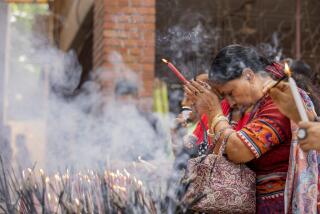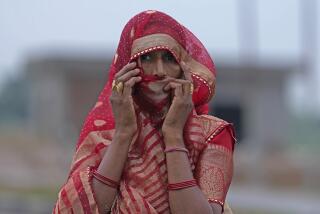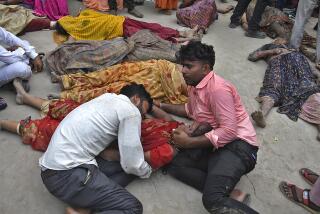Hindu Throng Demands Temple on Muslim Shrine Site : Unrest: The huge rally demonstrates the growing strength of the fundamentalist movement in India’s politics.
NEW DELHI — Hundreds of thousands of Hindu pilgrims, saints and politicians flooded the Indian capital Thursday in the largest single show of force by the Hindu revivalist movement that has been sweeping once-secular India.
Shouting “Long live Lord Rama!” the devotees filled every inch of New Delhi’s sprawling, downtown Boat Club park, bathing it in Hinduism’s spiritual color of saffron in a daylong rally to demand construction of a temple to the Hindu demigod Lord Rama on a site now occupied by a centuries-old Muslim shrine.
It was the biggest demonstration in New Delhi since India’s independence 44 years ago, and Indian analysts said the massive turnout was clear evidence that the Hindu fundamentalist movement that has mushroomed over the temple issue will now play a key role in determining the future of the world’s largest democracy and its minority of 100 million Muslims.
The Rama temple dispute already has triggered Hindu-Muslim violence that killed thousands throughout the country last year. It was instrumental in the fall of two national governments in the past two years, and the analysts said Thursday’s demonstration confirmed that the Hindu revivalists will wield unprecedented power in India’s coming national elections, now scheduled for late May.
“This is a historic crowd that has been built here today,” shouted L. K. Advani, leader of the Hindu revivalist Bharatiya Janata Party, or Indian National Party, which politically has benefited the most from the temple controversy.
“Never has there been a larger crowd since 1947. It is quite a show of strength. . . . And now it is clear that the power of Rama is the power of India.”
The rally was sponsored by the Vishwa Hindu Parishad, or World Hindu Council, which also is spearheading the drive to build the Rama temple on the site now occupied by the Babri Masjid mosque in the north Indian town of Ayodhya. The temple’s backers assert that the site is the birthplace of Lord Rama, a demigod in the Hindu pantheon who has developed a massive, grass-roots cult following throughout India in recent centuries. They also say Rama’s original birthplace temple was demolished by invading Moguls in the 1500s.
Throughout the procession of bearded saints, painted holy men and fiery politicians who addressed Thursday’s crowd, there were constant vows to build the temple at any cost and frequent threats directed at anyone who attempts to block it.
The Indian government, asserting that the campaign is a threat to India’s constitutional secularism, made such an attempt last October, when a group of 100 militant pilgrims defied mass arrests, tear gas and bullets in Ayodhya’s state of Uttar Pradesh to enter the disputed mosque and rip apart several sections of it with their bare hands.
“Uttar Pradesh will be totally destroyed if the government tries to stop the holy construction work again,” declared Ashok Singhal, spiritual head of the Hindu Council.
Standing beneath 20-foot-high, painted cutouts of the proposed temple and of the giant blue deity armed with bow and arrows, the speakers insisted that their cause is just, not only morally but historically--a symbolic struggle to reassert the religion of more than 80% of India’s 844 million people and remove all vestiges of colonial rule by both the conquering Islamic Moguls and the British after them.
“Ram epitomizes nationalism,” Advani shouted to a torrent of cheers and the blowing of holy conch shells. “Since Mahatma Gandhi’s campaign for independence, there has never been a bigger mass movement.
“Just as we’ve gotten rid of all the statues from the British time, structures like the Babri Masjid remain the epitome of foreign domination over India.”
It is through such nationalist and grass-roots religious appeal that Advani’s party hopes to win a majority in the next elections, riding a popular wave that saw it increase its seats in the 544-seat Indian Parliament from just two to 82 at the last election in 1989.
“We’ll free India again,” Advani vowed. “We won’t rest until this temple is built.”
The huge attendance at the rally, which police officials estimated at nearly 500,000, renewed the fears of Indian election officials and prominent intellectuals that the coming election campaign will rekindle the Hindu-Muslim violence that left thousands dead after last October’s carnage in Ayodhya.
In an effort to limit the violence, the Indian Election Commission issued an order this week barring politicians from linking religion and politics, an order that the rally’s organizers scoffed at Thursday.
“Religion and politics always go side by side,” said Shankaracharya Divyanandaji Bhanpurapeeth, a high-ranking Hindu priest and a member of the “parliament of saints” that met in New Delhi this week to plan their election strategy.
“When governments have failed to give us permission to construct the temple at Ayodhya, no other alternative is left for us than protest and pushing for the vote.
“Hinduism, you see, is not a religion. Hinduism is a way of life. The relationship between husband and wife is the same as the relationship between religion and politics.”
The message apparently was not lost even on the thousands of heavily armed riot police guarding the event. Several policemen dropped their canes and shields and sat among the audience, often cheering the speakers as loudly as the pilgrims, in a clear indication of the depth of the revivalist movement.
BACKGROUND
The north Indian town of Ayodhya has become a religious battlefield. Hindus regard the town as the birthplace of the demigod Lord Rama and as the site of a former temple honoring him. They claim that invading Moguls demolished the temple in the 16th Century and erected a mosque of their own. Muslims deny this and refuse to give up their claim to the crumbling mosque, known as the Babri Masjid. The temple-mosque conflict has led to thousands of deaths in Hindu-Muslim clashes across India in recent years. And it was instrumental in the fall of two national governments in the last two years.
More to Read
Sign up for Essential California
The most important California stories and recommendations in your inbox every morning.
You may occasionally receive promotional content from the Los Angeles Times.










